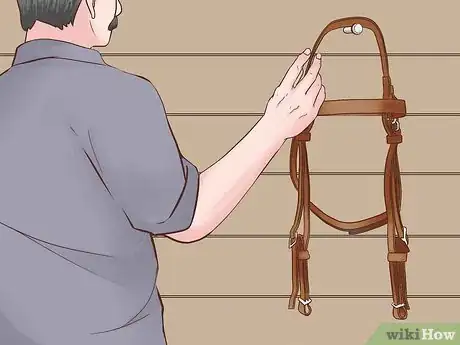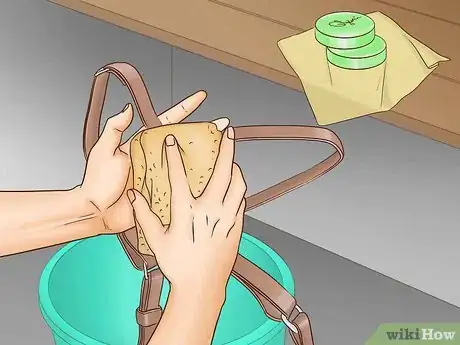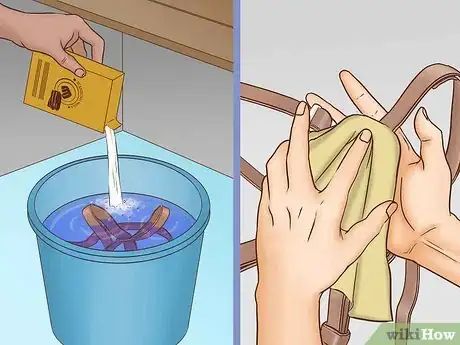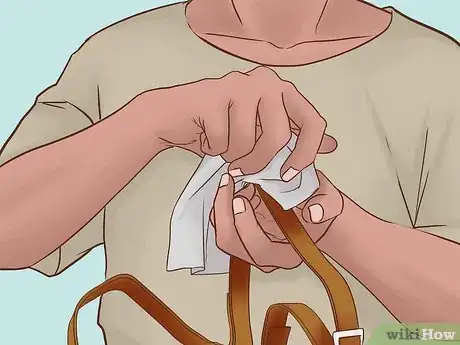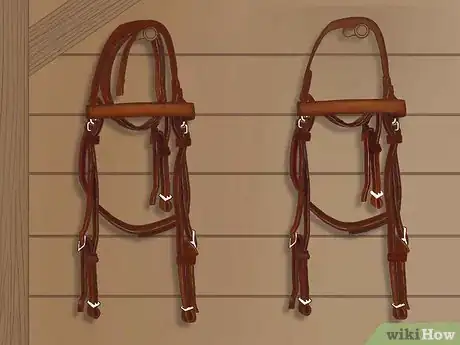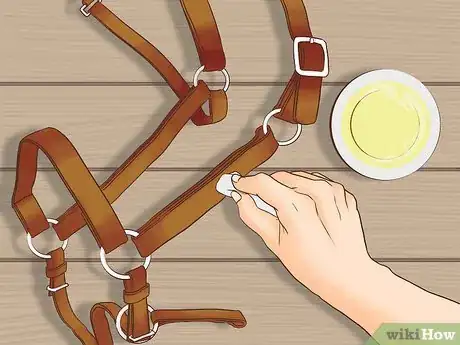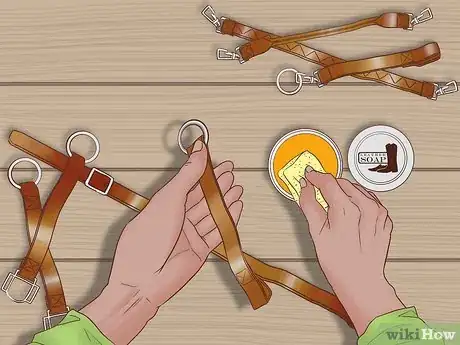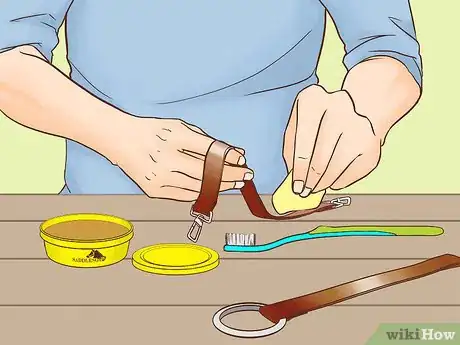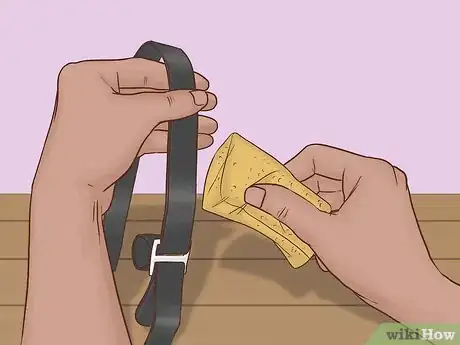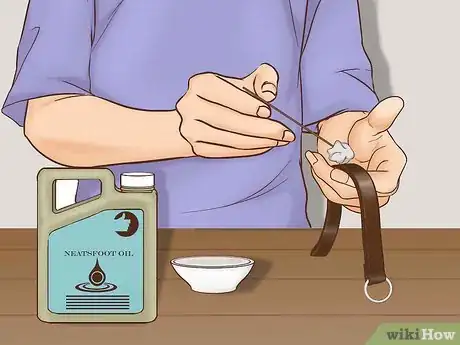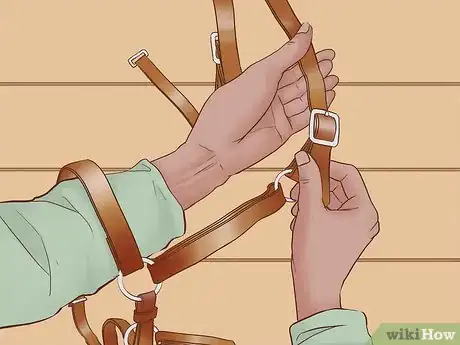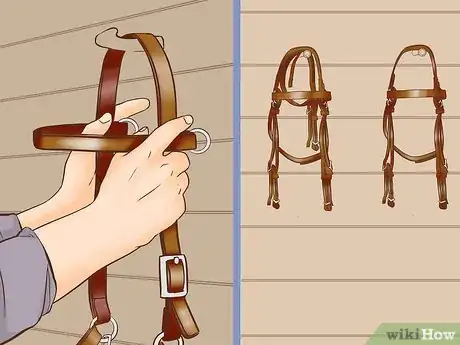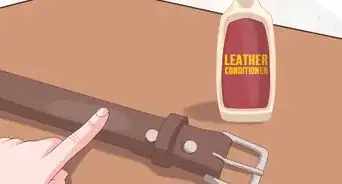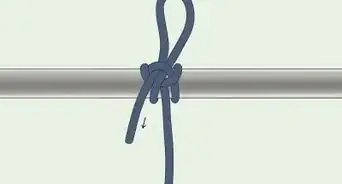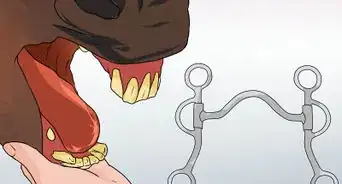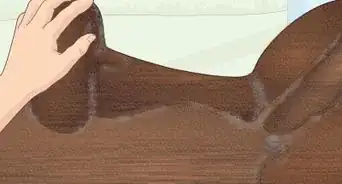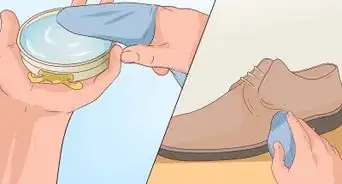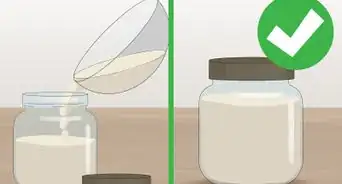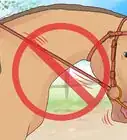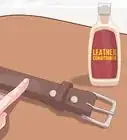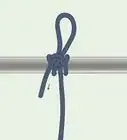This article was co-authored by wikiHow Staff. Our trained team of editors and researchers validate articles for accuracy and comprehensiveness. wikiHow's Content Management Team carefully monitors the work from our editorial staff to ensure that each article is backed by trusted research and meets our high quality standards.
There are 9 references cited in this article, which can be found at the bottom of the page.
This article has been viewed 75,985 times.
Learn more...
A leather bridle is a big investment and an essential piece of tack for many horse owners. With regular cleaning and oiling, your leather bridle will remain soft, supple, and beautifully crafted for many years to come. Clean the bridle regularly using soap and warm water. When it comes to oiling the bridle, take it apart first and condition each part using leather soap, saddle soap, and neatsfoot oil.
Steps
Cleaning a Leather Bridle
-
1Clean the bridle at least once per week if you use it daily. Some people prefer to clean their bridle every day. However, how regularly you clean your bridle depends on how often it is used. An infrequently used bridle won’t need to be cleaned as regularly as one that is used every day.[1]
- If the bridle gets very wet in the rain or if you notice that it is particularly soiled after a ride, clean it as soon as possible. Then let it dry for a few days in a cool, dark place. This will help to preserve the leather.[2]
- Cleaning your bridle regularly gives you a chance to check that all of the parts and stitching are in good working order. It will also help you to notice when repairs need to be done.[3]
-
2Wipe the bridle down using water and glycerin soap. Fill a small bucket with warm water. Apply glycerin soap to a cloth and dip it into the warm water to make it damp. Rub every part of the leather bridle with the cloth to help remove dirt and oils.[4]
- Alternatively, use a sponge rather than a cloth to clean the bridle.
- Glycerin soap is a soap that contains glycerin. You can purchase this from department stores, saddlery stores, and online.
Advertisement -
3Use washing soda to clean the bridle if it is heavily soiled. Fill a small bucket with warm water and mix in a small handful of washing soda. Then clean the bridle with the washing soda and water mixture using a cloth.[5]
- Washing soda is also known as sodium carbonate. You can find this at grocery stores.
- Washing soda is especially useful if you are finding it difficult to remove dirt or grease using just warm water and glycerin soap
-
4Clean off any residue with a damp cloth. Make sure that the cloth is only slightly damp as you don’t want to add more water to your bridle. Wipe the bridle down fully to prevent any soap building up, as this may harm the leather.[6]
-
5Hang the bridle on a peg to dry. Choose a cool, dark spot for the bridle to dry. If you are concerned about dust, cover the bridle with a soft cloth.[7]
- Pick a location to hang the bridle which has a consistent temperature. This prevents the leather from cracking.
Conditioning and Oiling a Leather Bridle
-
1Oil the bridle once per month. You don’t need to oil a leather bridle as often as you clean it. New bridles or bridles with very dry leather need to be conditioned and oiled more frequently than others.[8]
-
2Take the bridle apart fully. Unbuckle every latch and lay all of the parts out in front of you. Inspect the leather and all of the stitching to make sure that it is all in good condition.[9]
- For an English bridle, the parts you should have are a noseband, 2 cheek pieces, a throat latch, a headstall, a browband, and reins.
- For a Western bridle, you should have 2 cheek pieces, a headstall, reins, and potentially a throat latch depending on the bridle.
- The noseband goes across the nose, the cheek pieces go down the cheeks, the throat latch goes around the throat, the browband goes just below the ears, the reins connect to the bit, and the headstall goes above the ears and holds the whole bridle together. All of the parts are connected to the headstall.
-
3Use leather soap on all of the bridle parts and then wipe away the lather. Place the leather soap onto a sponge and work up a lather on every part of the bridle. Ensure that you clean all of the crevices in the bridle with the leather soap. Then use a clean cloth to remove the lather.[10]
- If you are using tinned leather soap, place the soap onto a sponge and then dip the sponge into warm water. Squeeze out the sponge so that it is only slightly damp and then create a lather with the soap. If you are using liquid leather soap, you will not need to add water.
- Never use products that are not specially designed for leather as a substitute for leather soap. Bleach, vinegar, vegetable oil, and motor oil are all ineffective and may damage the bridle.[11]
-
4Clean all of the bridle parts with saddle soap. Use a sponge to apply the saddle soap to the bridle and to work up a lather. If it is difficult to get the saddle soap into the stitching and crevices on the bridle, apply it with a toothbrush rather than a sponge.[12]
-
5Wipe away the excess soap and lather with a sponge. Use a clean and slightly damp sponge to wipe every part of the bridle. Check that there is no residue remaining.[13]
-
6Oil all of the bridle parts with neatsfoot oil. Apply the neatsfoot oil to a clean sponge and rub it into all parts of the bridle. Every part of the leather should have a thin coating of neatsfoot oil. Remove any excess oil using a sponge.[14]
- The thin layer of oil that remains on the bridle will slowly soak into the leather, to keep it soft and supple.
- Neatsfoot oil is a type of leather polish that is made from cattle bones.[15]
-
7Reassemble the bridle. Place the browband back onto the headstall and the throat latch. Then feed the noseband straps back into the headstall. Buckle the cheek pieces to the straps on the headstall and place the reins onto the bit.[16]
- Gently flex the leather as you put the bridle back together to help it become more supple.
-
8Let the bridle dry for 1-2 days. After you oil a leather bridle, the oil will need time to soak into the leather and to make it soft. Wait until the bridle is completely dry and check that it doesn’t feel oily or greasy before you use it again.[17]
- If the leather still feels brittle or hard after it has dried, condition and oil the bridle again.
Community Q&A
-
QuestionIs Murphy's Oil Soap a good cleaner for the bridle?
 Community AnswerYes.
Community AnswerYes. -
QuestionCould I use coconut or vegetable oil instead?
 Community AnswerYou can but it isn't anywhere near as good. Coconut oil leaves a white residue and vegetable oil leaves a slippery, oily feel. A coat of saddle condition or soap is much better.
Community AnswerYou can but it isn't anywhere near as good. Coconut oil leaves a white residue and vegetable oil leaves a slippery, oily feel. A coat of saddle condition or soap is much better. -
QuestionMy bridle gets really dirty with arena dirt, and it's hard to get off. I've tried scraping it with my fingernail, it comes off but it wont clean with any tack cleaner.
 Community AnswerI use saddle soap mixed with water to make a soapy liquid in a small container and then dip an old toothbrush into the mix repeatedly. Use the dipped toothbrush to scrub off the dirt and grime. Then I wipe off the excess with an old cotton rag (old singlets are great). Next, oil with a good leather conditioner, using your fingers, then leave in the sun for a short while to soak in.
Community AnswerI use saddle soap mixed with water to make a soapy liquid in a small container and then dip an old toothbrush into the mix repeatedly. Use the dipped toothbrush to scrub off the dirt and grime. Then I wipe off the excess with an old cotton rag (old singlets are great). Next, oil with a good leather conditioner, using your fingers, then leave in the sun for a short while to soak in.
Warnings
- Never use a leather bridle that is frayed or cracked as this can be dangerous for both you and your horse. Always ensure that the bridle is in good, working order before you use it.[18]⧼thumbs_response⧽
Things You’ll Need
Cleaning a Leather Bridle
- Leather bridle
- Glycerin soap
- Bucket
- Cloths
- Sponge
- Washing soda
- Bridle peg
Conditioning and Oiling a Leather Bridle
- Leather bridle
- Sponges
- Leather soap
- Saddle soap
- Toothbrush
- Neatsfoot oil
References
- ↑ https://www.mastersaddlers.co.uk/cleaning_and_tack_care
- ↑ https://www.mastersaddlers.co.uk/cleaning_and_tack_care
- ↑ https://dressagetoday.com/lifestyle/top-notch-care-for-dressage-tack
- ↑ https://dressagetoday.com/lifestyle/top-notch-care-for-dressage-tack
- ↑ https://www.mastersaddlers.co.uk/cleaning_and_tack_care
- ↑ https://dressagetoday.com/lifestyle/top-notch-care-for-dressage-tack
- ↑ https://www.mastersaddlers.co.uk/cleaning_and_tack_care
- ↑ https://dressagetoday.com/lifestyle/top-notch-care-for-dressage-tack
- ↑ https://www.equisearch.com/articles/leathertack-care-26255
- ↑ https://www.horsehealthproducts.com/horsemans-report/leather-care/a-spotless-reputation-tack-cleaning-tips
- ↑ http://info.mannapro.com/equine/the-commandments-of-leather-care-the-truth-behind-saddle-soap
- ↑ https://www.mastersaddlers.co.uk/cleaning_and_tack_care
- ↑ https://www.equisearch.com/articles/leathertack-care-26255
- ↑ https://www.equisearch.com/articles/leathertack-care-26255
- ↑ https://oilhealthbenefits.com/neatsfoot-oil/
- ↑ https://youtu.be/u71jCG4tI9M?t=43
- ↑ https://stablemanagement.com/articles/equine-tack-maintenance-reconditioning-dry-leather-29736
- ↑ https://esc.rutgers.edu/fact_sheet/saddling-and-bridling-horses-safely/
About This Article
To clean and oil a leather bridle, start by wiping the bridle down with water and glycerin soap using a sponge or cloth. Then, wipe down the bridle with a clean, damp cloth to remove any soapy residue, and hang it in a cool, dark spot to dry. Next, take the bridle apart completely, and rub a thin layer of neatsfoot oil into all of the parts. Finally, reassemble the bridle and let it dry for 1-2 days. To learn how to condition a leather bridle using leather soap, scroll down!
